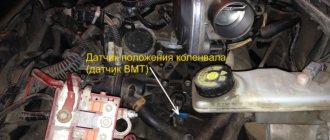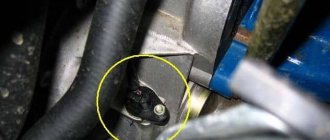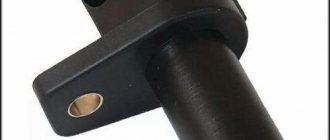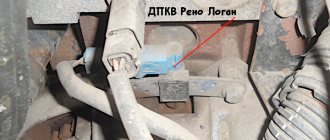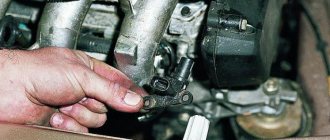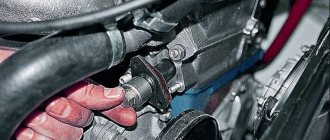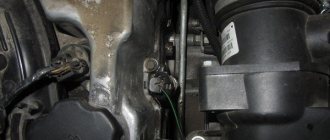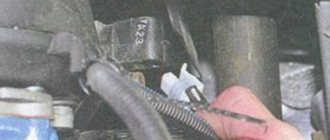One of the most important components of a modern car is the DPKV - crankshaft position sensor, signs of malfunction of which signal the driver about the need for urgent repair of this unit. Such immediate repairs are really necessary, since without it the car’s engine will stop.
Before you figure out how to determine a malfunction of the crankshaft sensor, also called the alarm indicator, you should decide what it is and what it is intended for. This unit allows the vehicle's fuel injection system to operate synchronously between the fuel injectors and the ignition system.
Its structure is quite simple: a nylon frame, wrapped in copper wire, is attached to a steel core. The wire is insulated with enamel, the role of a sealant is performed by a compound resin. During operation, the sensor sends signals to the ECU about the operation and position of the crankshaft.
A malfunction of the crankshaft position sensor deprives the vehicle system of the ability to establish a number of important characteristics - the amount of fuel injected and the fact of injection itself, the angle of rotation of the camshaft, the fact of ignition (gasoline engines) and others. This is why it is so important to know how to check the serviceability of the crankshaft sensor if you do not want to get stuck somewhere on a deserted road due to a completely stalled engine.
The car's ECU receives a signal from the crankshaft position sensor, we sorted it out. Thanks to this, the controller knows in what position the crankshaft is in relation to top dead center in the first and last cylinder, and knows at what speed the shaft rotates (in short).
This is very important, because by recording this data, the control unit can coordinate various signals for stable engine operation (ignition timing, impulse for fuel injectors, fuel pump operation, etc.). DPKV malfunctions are quite rare; often the sensor can last from the beginning of the vehicle’s operation until the end.
The most common cause of malfunction is mechanical damage; in most cases, car owners themselves are responsible for the breakdown during repair work in the engine compartment. If foreign objects get between the sensor and the crankshaft pulley, the DPKV will be 100% damaged.
A breakdown of the sensor makes it impossible to start the engine, since the ECU simply cannot control the operation of the internal combustion engine, and therefore driving is impossible. For owners of domestic cars and not only it is advisable to have a working sensor in stock; it costs a penny, but its absence at the right time can become a real problem. Especially if it breaks down somewhere on the track.
Regarding replacement, it is worth noting that before doing this it is better to make sure that the gap between the pulley and the sensor is not blocked by foreign objects, and also corresponds to the set values. In addition, dirt on the DPKV core can cause malfunctions.
Crankshaft sensor - signs of malfunction
The following symptoms of a crankshaft sensor malfunction, which are most understandable to the driver, can be identified:
- noticeable detonation in the engine under dynamic load;
- speed with signs of instability at idle;
- reduction in engine power, noticeable without instrument readings;
- a significant decrease in car dynamics while driving is a clear symptom of a malfunction of the crankshaft position sensor, which, however, may also indicate some other problems with the engine;
- The speed increases or decreases uncontrollably.
Also, evidence that the crankshaft position sensor is faulty is the banal inability to start the car engine . Thus, you do not need to be a super professional in matters of car electronic circuits to identify signs of a malfunction of the crankshaft position sensor.
How to check the crankshaft position sensor
The performance of a given node can be analyzed in several ways. You just need to stock up on the necessary instruments, remove the synchronization sensor from the engine, inspect it and proceed directly to the test.
Note that during an external inspection it is possible to establish certain damage to the contact block, core or housing of the DPKV. Sometimes simple cleaning of cores and contacts from contamination solves all problems.
If no obvious defects in the unit are identified, you should begin checking for “hidden threats.”
How to test the crankshaft sensor with an ohmmeter This, frankly speaking, elementary option allows you to easily solve the problem of how to check the crankshaft position sensor for serviceability. Using an ohmmeter you just need to measure the resistance of the DPKV winding. For most vehicles, its normal value varies from 550 to 750 Ohms.
The second verification method is more complex and involves the use of:
- ohmmeter and megohmmeter to measure resistance (as indicated earlier);
- inductance meter, normal value - from 200 to 400 mH;
- a digital voltmeter (a conventional device can also be used) and a network transformer.
The measurement results give a clear answer about whether the crankshaft position sensor is working or faulty.
- Marina
Source: https://carnovato.ru/datchik-kolenvala-priznaki-neispravnosti/
Замена датчРеРєР° фазы РЅР° Ладе RљР°Р»РёРЅРµ SЃРІРѕРёРјРё SЂСѓРєР°РјРё
Первым делом немного РѕР± РєРхструменте, который РїРѕР SR°РґРѕР±РёС‚СЃСЏ для выполненния дадорѕРіРѕ РІРёРґР° SЂРµРјРѕРЅС‚Р°. Рљ счастью, здесь RјРѕР¶РЅРѕ RѕР±РѕР№С‚РёСЃСЊ RѕРґРЅРёРј S‚олько ключо Рј РЅР° 10. РќРѕ лучше всего Нпольз овать кенно головку СЃ воротком, Р° еще SѓРґРѕР±РЅРµРµ — тре S‰РѕС‚РєСѓ. Просто обычным ключом делать SЌS‚Рѕ будет довольнР* неудобРСРѕ.
RќР°РіР»СЏРґРСРѕ сначала стоит RїРѕРєР°Р·Р°С‚СЊ, РіРґРµ РІСЃРµ SЌС‚Рѕ РЅР°С…РѕРґРёС ‚СЃСЏ:
RS‚ак, сначала нужно будет отсоединить S€S‚екер питан РёСЏ, предварительно отж ав пластРековый фиксатор, немного RїСЂРёРїРѕРґРЅСЏРІ его РІРІР µСЂС…:
После чего трещоткой откручиваем болт РєСЂРµРїР»РµРЅРёС Џ датчРеРєР° фаз Калины :
R S‚еперь RјРѕР¶РЅРѕ SЃРІРѕР±РѕРґРЅРѕ RµРіРѕ RІС‹РЅРјР°С‚СЊ, RїРѕС‚СЏРЅСѓРІ РІ СЃС‚ РѕСЂРѕРЅСѓ лобового SЃС‚екла:
Рђ РІРѕС‚ так выглядит данная деталь, снятая СЃ автомо±РёР "СЏ:
После этого выполняем замену датчика SЂР°СЃРїСЂРµРґРІР°Р»Р° Рё SЃС‚авРеРј новый РЅР° прежнее RјРµСЃС‚Рѕ . Сложностей РІ процессе SЂР°Р±РѕС‚С‹ нет абсолютно РЅРекакРYoS….
Цена его РІ СЂРѕР·РЅРЕчной продаже составляет РѕС‚ 250 РґРѕ 300 СЂС ѓР±Р»РµР№, РІ заввисимости РѕС‚ того , РіРґРµ РІС‹ будете его покупать. Конечно, выходит РёР· строя эта деталь РЅР° Калине РґРѕРІРѕР» СЊРЅРѕ редко, РЅРѕ РІСЃРµ же данная РёРЅСЃС‚ SЂSѓRєS†РЅРёРєРѕРјСѓ РЅРµ RїРѕРјРµС€Р°РµС‚.
РЈ меня Калина седан 2006Рі выпуска. РџСЂРё включении зажРегания РЅРµ РіРѕСЂРёС‚ чек,топливный насо СЃ РЅРµ качает,после чего РЅР ° панели РїСЂРеР±РѕСЂРѕРІ загорается R»Р°РјРїР° иммобилайзера,машина РЅРµ заводит SЃСЏ! РЇ вынимают предохранитель насоса Рё вставляю его RѕР±СЂ атно РІ реле зажРегания СЃР »С‹С€РµРЅ треск,после S‡РµРіРѕ RјР°С€РёРЅР° заводится! RџРѕРґСЃРєР°Р¶РёС‚Рµ что это RјРѕР¶РµС‚ быть?
RџСЂРѕРІРµСЂСЊ RR'РЈ. Ресли РЅРµ перенес его РёР· РїРѕРґ RїРµС‡РєРё RѕР±СЏР·Р°С‚ельно это СЃРґРµ лай. Р'ыло Сѓ меня такое чек РЅРµ РіРѕСЂРёС‚, стартер даже РЅРµ РїСЂРѕР±С ѓРµС‚ крутить. Оказалось залит РР'РЈ. Сушить РЅРµ варРеант-пришлось брать новый. Надеюсь, что РјРѕРіСѓ ошибиться Рё Сѓ тебя что-то более РїСЂР ѕСЃС‚РѕРµ.
Crankshaft sensor Lada Granta
The DPKV or crankshaft sensor for the Lada Granta is one of the most important measuring units in the entire car. Its purpose is to measure the rotation speed of the crankshaft, as well as its position. While reading the parameters, the sensor sends signals to the controller, which processes this data and issues the necessary impulses to the injectors.
The unit itself is quite reliable in operation and rarely fails. However, if its performance is impaired, this causes significant problems for the further operation of the engine. In addition, the product itself is non-repairable and therefore must be replaced with a new one.
Where is the crankshaft sensor located in Grant?
The device is located next to the oil filter in the left, rear part of the car engine. More precisely, on the generator drive pulley.
Functionality check
Be sure that if the DPKV breaks down, it will be difficult to start your car’s engine. The product does not have moving parts, so it is not possible to identify the causes of malfunctions at a quick glance. The most common causes of breakdowns:
- destruction of electrical wiring due to corrosion;
- break, short circuit of the DPKV coil winding.
Main symptoms of a malfunction:
- problems with starting the engine (including inability to start);
- stalling motor after it reaches operating temperature;
- unstable operation of the internal combustion engine, its detonation and loss of power.
In order to check the sensor, you need to dismantle it, connect the multimeter probes to its contacts and measure the resistance level. Which probe is connected to which connector is not of fundamental importance. Before connecting the multimeter to the sensor connectors, do not forget to switch the measuring mode of the device to the “2K” position.
The resistance level of the working sensor must correspond to the following intervals: 550-750 Ohms. There are other diagnostic methods. For example, checking the sensor without removing it from the car. To do this, you need to disconnect the contact chip from the DPKV connector and connect a multimeter.
After that, you need to rotate the crankshaft pulley and at the same time observe the readings on the display of the measuring device. The voltage should be 0.3 Volts.
The phase sensor has failed - error 0343
About a week ago, after checking the compression in the engine of my Kalina, an error appeared from BC State: 0343 - high signal level of the phase sensor. But the "Check" did not light up. At first I thought that this was a temporary error, since I was turning the engine with the starter without spark plugs. But after long-term manipulations with resetting all errors and even after resetting the ECU on my Kalina, I did not achieve any results.
After the reset, the error disappeared, and for some time the on-board computer did not show any faults. But this did not last long, approximately after the next start of the engine, a warning with code 0343 was again displayed on the State display. I tried to remove the terminal from the battery and move the connector on the ECU, I thought it might come off a little. But nothing helped.
I went to the store, looked at the prices of the phase sensor for Kalina, and there they were 280 rubles each. I decided to go to the car market in the hope of finding something cheaper. But in each tent the prices were 300 rubles. But after haggling a little, the seller knocked off as much as 50 rubles. I immediately put it in place, and - Oh, miracle, the error disappeared and for several days now I haven’t remembered it. We can say that this is the first real breakdown on my Kalina in 2.5 years of operation.
I put the old camshaft position sensor in the glove compartment, just in case. Although, I think that even after this sensor fails, you can drive quite well. Tested from personal experience with my Kalina - after removing the plug from the phase sensor, the engine characteristics do not change in any way, even instantaneous fuel consumption remains the same.
Crankshaft position sensor VAZ: Priora, Kalina. Location, check, malfunctions
The crankshaft position sensor (CPS) is used by the ECM to determine the rotation angle and speed of the engine crankshaft.
During engine operation, the crankshaft master disk crosses the magnetic flux of the DPKV, inducing alternating voltage pulses in its winding. Using this data, the controller calculates the duration and phase of operation of the fuel injectors, as well as the ignition system.
Where is the sensor located?
A toothed drive disk is attached to the engine crankshaft (combined with the generator drive pulley). At a distance of approximately 1mm (plus or minus 0.4mm) from the top of its tooth, a crankshaft position sensor is attached to the oil pump cover
4x4 crankshaft position sensor
Crankshaft position sensor Priora, Kalina
The drive disk has 58 teeth in six-degree increments, as well as a “groove” formed by two missing teeth - thus achieving synchronization. To install the crankshaft at a position of 114 degrees before the top dead center of the first and fourth cylinders, align the middle of the first tooth after the cavity with the DPKV axis.
The DPKV wires are protected from interference by a screen connected to the vehicle ground.
A malfunction of the DPKV circuit causes the engine to stop, an error code to be entered into the controller's memory and the warning light to turn on.
Checking DPKV circuits
We check the DPKV circuits after turning off the ignition and the pads from the controller and the sensor itself. As can be seen in the presented connection diagram, we check the continuity of the circuit between contacts “A” of the DPKV block and contact “X2/13” of the controller block, as well as between contact of the sensor block “B” and contact “1” of the controller block.
If the DPKV circuits are in good working order, its installation is reliable and an error code indicating a sensor malfunction is stored, the DPKV must be replaced.
Replacing the crankshaft position sensor
Removal
- Turn off the ignition.
- Disconnect the wire block.
- Using a wrench x10, unscrew the bolt securing the DPKV to the oil pump cover.
- Remove the sensor.
Installation
- Put the DPKV in place.
- Screw in the fastening bolt and tighten it to a torque of 7.8…12.6 N.m.
- Connect the wire block to the sensor.
Subscribe
to our channel in
Yandex.Zen
Even more useful tips in a convenient format
Subscribe
Did not find an answer to your question?
Ask in x. We will definitely answer!
for repair of VAZ (Lada) Kalina I
Source: https://etlib.ru/blog/193-datchik-polozheniya-kolenchatogo-vala-priora-kalina
Functions of DPKV
For efficient operation of the internal combustion engine, the fuel mixture must be supplied to the combustion chambers with the piston position at bottom dead center. The spark that will ignite the gasoline (when everything is in good condition) is supplied in the TDC position, after the mixture is compressed by the piston. In order for the ECU to send a control signal to the fuel pump, injectors and ignition system in a timely manner, it must know in what position the crankshaft and, accordingly, the pistons are located. Signs of a malfunction of the VAZ-2110 crankshaft sensor will be associated with untimely injection and lack of spark.
If the DPKV fails, the car will literally “go blind”. Fuel will not be supplied to the cylinders at all or it will be ineffective. The ignition process will be chaotic.
Signs of a malfunctioning crankshaft sensor: VAZ 2114, 2110, Kalina, Opel, etc.
Sensors, control systems, tracking circuits, executing and transmitting electronic circuits... Twenty years ago these terms could not be associated with the design of a car, but today it is impossible to even imagine a modern car without them. Whether we like it or not, we will have to come to terms with them, because when some sensors fail, they can simply blink a light goodbye, and without some sensors the car will not move forward. The latter includes the crankshaft position sensor, a simple device, without which all electronics turn into a pile of rubbish.
In the photo - crankshaft sensor VAZ 2110
What is a crankshaft sensor
It can be called differently - a top dead center sensor, a crankshaft position sensor, a synchronization sensor, but this is the only magnetized piece of hardware in a nylon body that can immobilize a car. Its main task is to determine as literally as possible the moment the spark pulse is applied to the spark plug contacts.
This sensor is the reference point for the operation of the ignition system and the electronic fuel injection control system. An incredibly simple device - just a wire with varnish insulation is wound around a magnetized core and the whole thing is housed in a plastic case. Sometimes it is filled with a two-component resin, sometimes it is simply melted into plastic.
This is a regular inductance sensor, which works on the simplest principle.
If the task is to calculate the position of the crankshaft, then a synchronizer disc is attached to it, which can be combined with the clutch flywheel or with a pulley at the front end of the crankshaft. Since the core is magnetized, it reacts with an impulse to any movement of a metal object near its surface. These objects were the teeth of the crankshaft pulley.
When the crankshaft rotates, the flywheel or pulley flickers its teeth in front of the sensor, constantly generating electrical impulses. These pulses are fed to the electronic control unit and, based on their frequency, the unit calculates the moment the spark is fired. Only if the impulse were constant would there be any possibility of ascertaining the true position of the crankshaft.
Therefore, it is necessary to remove one or more teeth so that the electronic control unit understands that the gap in the flow of pulses is the very position of the crankshaft when it is necessary to supply a spark to the spark plugs. For example, on the Gazelle and Volga there would be 60 teeth on the crankshaft pulley, but two of them are cut out to inform the ECU about the top dead center on the first and fourth cylinders.
Causes of failure
There are several reasons why a sensor can fail. Below is a list of reasons contributing to sensor failure:
- Aging;
- The magnet on the sensor is clogged;
- Mechanical shock to the sensor;
- Open circuit;
Let's look at each of the reasons in more detail.
Aging
This reason is caused by natural factors of aging of the sensor parts, that is, the scattering of plastic, exposure of the electrical connector into which moisture can enter and cause a short circuit.
Magnet clogged
The magnet is the main element of the sensor that takes readings. When it is clogged, various metal shavings often stick to the sensor head, making it difficult for the sensor to operate. In case of such a breakdown, it is necessary to clean the sensor head from chips.
Mechanical shocks
Impacts to the sensor are possible when driving on a gravel road, when stones from under the wheels fly everywhere. Such impacts can damage the plastic housing of the sensor or break the power supply wiring.
Open circuit power supply
This problem occurs quite often and is explained by aging there and improper laying of the wire during various repairs, such as replacing the timing belt, etc. Very often the wire is laid next to the exhaust manifold, which, with its high temperature, negatively affects the insulation of the wire, destroying it and damaging that very screen.
Checking and replacing the crankshaft position sensor Lada Kalina
The crankshaft position sensor is designed to generate signals by which the ECU synchronizes its operation with the engine operating cycles.
Therefore, this sensor is often called a synchronization sensor. The operation of the sensor is based on the principle of induction - when the teeth of the crankshaft pulley pass past the sensor core, AC voltage pulses appear in the sensor circuit. The frequency of occurrence of pulses corresponds to the speed of rotation of the crankshaft. The teeth are located around the circumference of the pulley (every 6°).
Two of them are separated from each other at an angular distance of 18°.
This was done to form reference signals in the sensor circuit - unique reference points, relative to which the ECU determines the position of the crankshaft - top dead centers in the first - fourth and second - third cylinders.
It is impossible to operate an engine with a faulty crankshaft position sensor. The crankshaft position sensor cannot be repaired; in the event of a malfunction, it is replaced as an assembly.
- Removing and installing the crankshaft position sensor
- Use a screwdriver or finger to press out the plastic latch securing the wiring harness block and disconnect the block from the sensor.
Unscrew the sensor mounting bolt with a 10mm wrench
...remove the sensor from the cover boss hole.
Check the sensor resistance. For a working sensor it should be 0.55–0.75 kOhm.
- Install the crankshaft position sensor in the reverse order of removal.
- Using a set of feeler gauges, we check the gap between the end of the sensor and the teeth of the crankshaft pulley.
- The gap should be 1±0.41 mm; it is specified by the design of the sensor and is not adjustable.
- With the ignition off, disconnect the engine management system wiring harness block from the crankshaft position sensor.
- We connect the tester probes to terminal “B” of the wiring harness block and engine ground.
- With the ignition on and the crankshaft stationary, the tester should record a voltage of about 2.5 V.
- A similar voltage should be between terminal “A” of the wiring harness block and engine ground.
- If the voltage values do not correspond to the norm, check the serviceability of the circuits (open and short to ground) between terminal “B” of the wiring harness block and terminal “34” of the controller, as well as between terminal “A” of the block and terminal “15” of the controller.
- If the voltage values do not match and the circuits are working, the controller is faulty.
- You can also check this way:
- We connect a multimeter to the sensor terminals (in voltmeter mode with a measurement limit of up to 200 mV).
- We quickly bring the blade of a screwdriver near the end of the sensor, while we observe voltage surges on the voltmeter.
Method No. 2
Using this method, you can determine much more accurately what state the component is in. For diagnostics you will need a voltmeter - it is better to use a digital device. It can be purchased at any radio market. You will also need a megohmmeter, an inductance measuring device and a transformer - it is better to choose a network one.
To obtain the most accurate indicators, diagnostics should be carried out in a temperature range from 20 to 22 degrees. First, measure the inductance of the DPKV winding with an inductance meter. If the element is working properly, the device will show from 200 to 400 MHz. Symptoms of a bad crankshaft sensor 2114 in this case indicate that the problem is somewhere else. Using a megger, insulation diagnostics are carried out. If voltage levels are more than 500 V, then the insulation value will not exceed 20 MΩ.
Replacing the crankshaft sensor Lada Kalina
Discussion of the section Replacing the crankshaft sensor Lada Kalina
Bakhyt
Tell me a secret... there are no errors. The manufacturer feels strange. It’s as if the probe doesn’t hit the tooth. He measured the shafts according to the mark and measured the knee with a bar at the very top mark. And when it’s idling. That is, there’s no vibration. More often than not, there’s some. vibration. I have an automatic transmission.
This is especially felt when the brake is stopped and the gear is on. For example, at a traffic light. I’ve already climbed everything. Instead of a computer, I have bluetooth through the phone. There the ignition angle advance shows from 1.3 to 4.6. This is approximately. There is no air suction. It shows 32-35... the throttle. then 0.75 then 1.75%.
this is all the data at idle
Regan
I have a Vesta, but lately it hasn’t driven at all. When I press the gas, the car sputters and slowly picks up speed. Can anyone give any advice on what this could be?
- Dwane
- I would like to know whether the key should be stored in the Lock or Unlock state?
- Bakerkin Alliance
good afternoon, you said that 2 relays need to be changed, but the video shows that you only changed one - the fuel pump. Why didn't they change the main relay?
- Jamshir Bagrat
- What if there are four
- Haydar
- what if magneto was to test the cam sensor would his body throw the magnetism off or would rolph harris wobbly his pheddo board
- Vita
Screw it Sasha screw it!?
Faiz
Dear Sasha, what do you breathe in there when you blow it out and wash it? Urgently do forced ventilation, at least exhaust!
- Glad
- And because of the throttle valve it may stall when you switch to D
- Kula
And from what Ford are these studs? I’ve already watched the second video, but it still hasn’t said which engine the studs need to be taken from on the camshaft yoke!
Sheroz
Igor, can you tell me how thick the leather belt spacer was? Lykos already installed!

